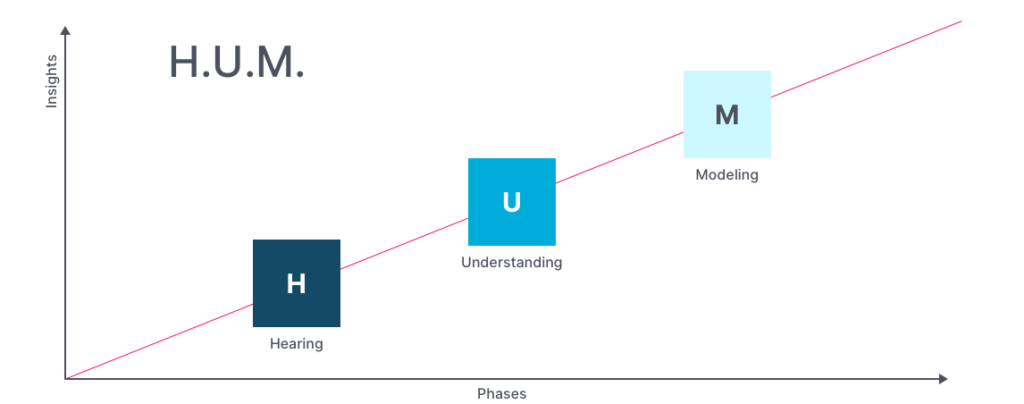The Importance of Customer Persona Interviews using the HUM Principle
Customer persona interviews are a key tool in understanding your target audience and developing effective marketing strategies. These interviews allow businesses to gain a deeper understanding of their customers’ needs, behaviors, motivations, and pain points.
By using a customer-centric approach, businesses can create products, campaigns, and customer experiences that resonate with their target audience.
One framework that can be used to guide customer persona interviews is the HUM principle, which stands for Hearing, Understand, Modeling. The HUM principle is a powerful tool for gaining insights into your target audience and creating empathy for your customers.

Here’s a closer look at each step of the HUM principle:
1 - Hearing
Hearing, Listening, Observing
Intentional Listening and Curiosity: Intentional and curious questioning is used to actively seek out information and insights.
It’s critical to ask open-ended questions that encourage customers to share their experiences and points of view.
Intentional Objectivity and Empathy: Using empathy and objectivity during the customer persona interview process.
It is critical to recognize that customers have unique perspectives and experiences, and to approach the interview with an open mind.
Seek Meaningful Findings: This includes looking for insights that can help inform your marketing strategies and improve your customer experience. It’s critical to zero in on the most important and actionable insights and use them to inform your marketing and product development strategies.
2 - Understanding
Interpretation, Understanding, Discernment
Critical Thinking: This involves approaching the customer persona interview process with a critical eye and questioning assumptions. It’s important to use critical thinking to validate findings and to ensure that the insights gained are reliable and accurate.
Identify Patterns: This involves identifying patterns in the data and information gathered during the customer persona interview. These patterns can provide valuable insights into customer behaviors, preferences, and motivations.
Translate into Insights: This involves taking the patterns and insights identified and translating them into actionable steps for your business. This step requires creativity and a willingness to experiment and iterate, in order to ensure that your marketing strategies and customer experience are continuously improving.
3 - Modeling
Framing, Modeling, Communicating
Frames Insights and Problems: This entails identifying the most pressing and relevant issues for your customers and framing them in such a way that the insights and problems that need to addressed are highlighted.
Buyer’s Story: Using the information gathered during the customer persona interview, create a model of the buyer’s story. This model, which should be used to inform your marketing strategies, should be based on customer needs, pain points, motivations, and behaviors.
Create a Narrative: This involves communicating the insights and findings from the customer persona interview in a clear and compelling way, using a narrative that resonates with your target audience and drives action.
Businesses can gain a better understanding of their customers and create customer personas based on real data and insights by employing the HUM principle. These personas can then be used to inform product development, marketing, and customer experience strategies.
As a result, customer persona interviews are an essential tool for understanding your target audience and developing effective marketing strategies.
By using the HUM principle, businesses can gain a deeper understanding of their customers, create empathy with them, and create products, campaigns, and customer experiences that resonate with their target audience.
As strategic digital experts, we assist companies in becoming and remaining valuable to their customers through marketing, sales, psychology, and business design. More information
© 2021 ROOPI. All rights reserved
